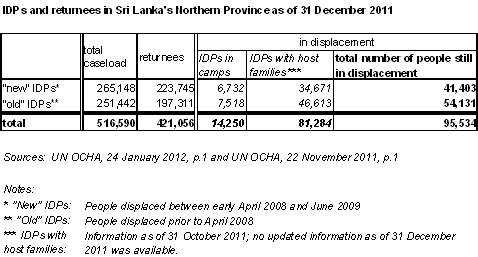Ilankai Tamil Sangam30th Year on the Web Association of Tamils of Sri Lanka in the USA |
|||
 Home Home Archives Archives |
Numbers of IDPs in Sri Lankaby Internal Displacement Monitoring Centre, Geneva, accessed April 19, 2012
The main sources for internal displacement figures in Sri Lanka are government figures as published in the monthly Joint Humanitarian Updates (JHUs) and the Common Humanitarian Action Plans (CHAPs), both issued by the United Nations Office for the Coordination of Humanitarian Affairs (UN OCHA). In addition, estimates of numbers of IDPs in Sri Lanka can be found in news articles and NGO reports.
“New” IDPs More than 6,700 “new” IDPs were staying in the Menik Farm temporary camp. In addition, more than 34,000 were living with host families. As a result, over 41,000 “new” IDPs remained in displacement. More than 223,000 had returned to their homes, where many remained in need of protection and assistance (UN OCHA, 26 January 2012, p.1; UN OCHA, 22 November 2011, p.1). “Old” IDPs Among “old” IDPs, more than 197,000 had returned, while more than 7,500 were staying in camps and more than 46,000 with host families, meaning that more than 54,000 “old” IDPs were still living in displacement (UN OCHA, 26 January 2012, p.1; UN OCHA, 22 November 2011, p.1). The “old” IDPs and returnees included more than 70,000 people displaced because their home areas had been declared part of High Security Zones (HSZ), and between 60,000 and 100,000 Muslims who were forced from their homes by the LTTE in 1990 and who were staying in Puttalam district (Raheem, 4 November 2009; UNHCR, 31 March 2010, p.6; NRC, 21 June 2010, p.2; GoSL, 5 December 2009). It remains unclear how many among each sub-group had returned and how many were still displaced as of December 2011. It was reported that a “significant number” of Muslim IDPs who had returned to Mannar had gone back to Puttalam after a short period of time, presumably because conditions for reintegration were not in place there (UN OCHA, 24 June 2011, pp.1-2). 
Sources Government of Sri Lanka, 5 December 2009, Displaced Muslims to be resettled - Minister Bathiudeen Raheem, Mirak, 4 November 2009, The Other Half of the IDP Problem: The Old IDPs |
||
|
|||